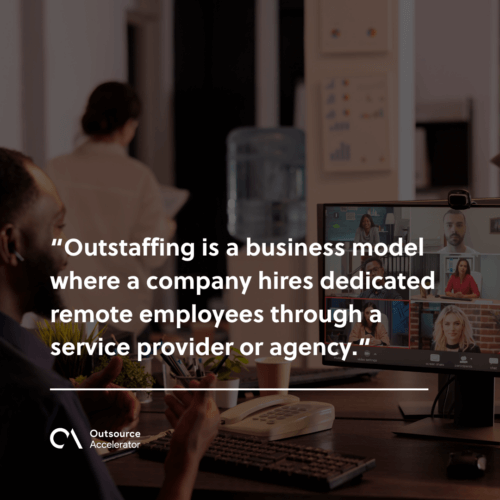Outstaffing: A strategic approach to scaling your business

Have you ever found yourself wishing you could access specialized talent for your business without having to deal with the headaches and expenses of hiring full-time employees?
Outstaffing might just be the solution you’ve been looking for. For those who’ve experience running a business, you’ll know how challenging it can be to find the right talent and keep costs manageable.
In this article, we’ll dive into the ins and outs of outstaffing and see how it could change the game for businesses of all sizes.
What is outstaffing?
Outstaffing is a business model where a company hires dedicated remote employees through a service provider or agency. These hires then become an integral part of the client’s team.
Unlike traditional outsourcing, where the entire project or task is outsourced to a third-party, outstaffing focuses on hiring skilled professionals to work exclusively for a specific client.
These remote employees, often located in different countries or regions, are selected based on their expertise and suitability for the client’s requirements.
Outstaffing allows companies to access talent without the need to hire additional in-house employees.

Outstaffing vs. Outsourcing
While likely to be seen as similar methods, there are a few points that differentiate outstaffing and outsourcing.
Understanding these key differences can help businesses choose wisely when considering external talent acquisition:
Nature of engagement
In outsourcing, a company contracts out an entire project, task, or process to a third-party service provider. The service provider is responsible for completing the work independently and delivering the final product or service back to the client.
With outstaffing, a company hires remote employees through a service provider to work exclusively for the client. These employees become an integrated part of the client’s team, collaborating closely with the in-house staff on specific tasks or projects.
Level of control and management
In outsourcing, the client has minimal control over how the project or task is executed. The service provider manages the outsourced work and is responsible for delivering results as per the agreed-upon terms.
With outstaffing, the client has more control and direct supervision over the remote employees. Clients can manage the outstaffed team, assign tasks, provide feedback, and include them into the company’s workflow as if they were in-house employees.
Focus on talent acquisition
Outsourcing focuses on finding a service provider that can handle a specific project or task efficiently. The emphasis is on the service provider’s overall capabilities rather than individual talents.
Outstaffing prioritizes hiring skilled professionals with specialized expertise to work exclusively for the client. The focus is on recruiting and retaining top talent to complement the client’s existing team and meet specific skill requirements.

Flexibility and scalability
Outsourcing offers scalability by allowing companies to scale up or down based on project requirements quickly. Companies can easily adjust the scope of work by renegotiating contracts with the service provider.
Outstaffing also provides scalability, but with more flexibility in terms of adjusting team size and composition. Clients can easily add or reduce the number of remote employees to match fluctuating workloads or changing business needs.
Cost structure
The cost structure in outsourcing is typically project-based or fee-based, with clients paying for the completed project or service as agreed upon in the contract.
In outstaffing, clients pay a fee for the dedicated remote employees, usually on a monthly basis. This fee covers the salaries, benefits, and overhead costs associated with the outstaffed team.
Benefits of outstaffing
Innovative businesses are embracing the power of outstaffing to tap into niche expertise, fortify their workforce with top talent, and adapt swiftly to the demands of the modern market.
Some benefits of outstaffing that they see include:
Access to specialized talent
Outstaffing allows companies to tap into a global talent pool and hire skilled professionals with specific expertise that may be difficult to find locally.
This ensures that the client has access to top talent to meet their project requirements.
Cost-effectiveness
Companies can significantly reduce costs associated with hiring full-time employees, such as salaries, benefits, office space, and training.
Outstaffing providers typically handle administrative and HR-related tasks, further lowering operational expenses.
Flexibility and scalability
Outstaffing offers flexibility in adjusting team size and composition based on project requirements or business needs. Companies can easily scale their teams up or down without the constraints of traditional hiring processes.
Enhanced efficiency
With a dedicated remote team, companies can improve efficiency and productivity in project execution.
Remote employees work exclusively for the client, allowing for better integration with the in-house team and seamless collaboration.
Global reach
Outstaffing enables companies to establish a global presence and expand their operations beyond geographical boundaries.
Remote teams can work across different time zones, allowing for around-the-clock productivity and faster project turnaround times.
Risk mitigation
Outstaffing providers often offer flexibility in contract terms and provide backup resources in case a team member is unavailable. This helps mitigate risks associated with project delays, staff turnover, or unforeseen circumstances.
Cultural diversity and perspective
Working with a diverse remote team can bring different perspectives, ideas, and approaches to problem-solving. Cultural diversity within the team can foster innovation and creativity in project development.

Quality assurance
Outstaffing providers typically adhere to quality standards and best practices in recruitment, training, and project management.
This ensures that the client receives high-quality deliverables and services from the remote team.
Long-term partnerships
Outstaffing fosters long-term relationships between clients and remote employees, leading to continuity, trust, and improved collaboration over time.
Building strong partnerships with remote professionals can result in consistent project success and business growth.







 Independent
Independent




